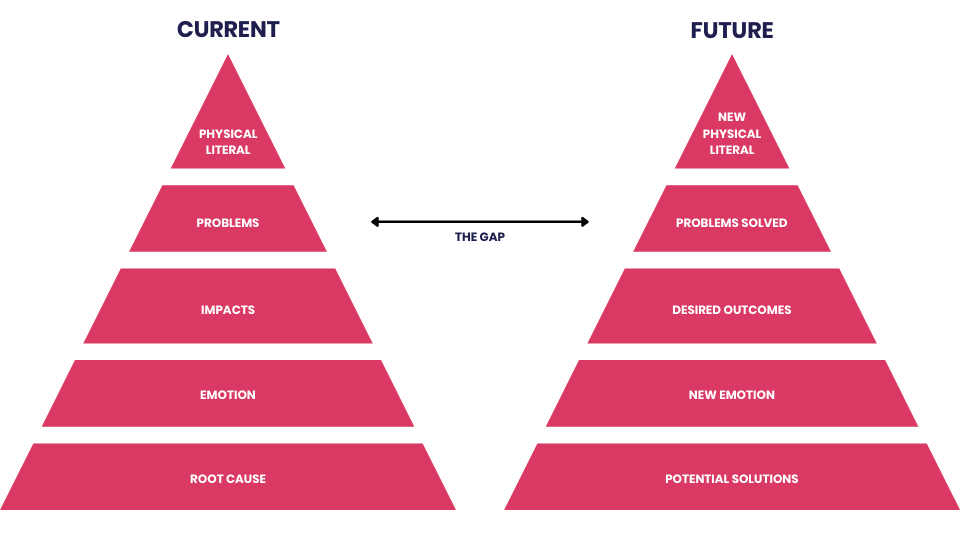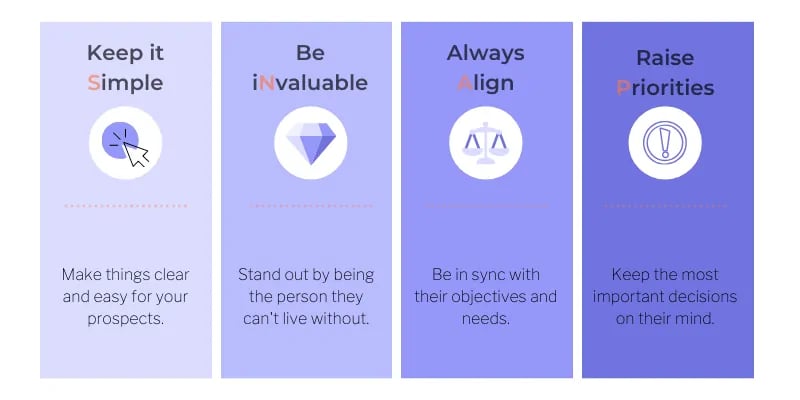A sales methodology gives you a structured approach to moving prospects through your pipeline and closing deals.
The examples we’re going to look at aren’t short-term sales trends. Instead, they’re timeless strategies that any salesperson or organization can use to level up their sales process and convert faster.
We’ll look at what sales methodologies are, their benefits, and five of the best sales methodologies you can implement at your company.
Let’s jump in.
What is a sales methodology?
A sales methodology is a framework for salespeople in your company to follow when engaging with prospects. It suggests what to do at each stage of the sales process – from your first cold email to your final email with your sales proposal – and the best way to guide a prospect through the buying process. The email design can be quickly completed using a no-code email builder, saving time and allowing you to focus on your sales.
In most cases, sales methodologies are broad strategic suggestions rather than short-term tactical steps. Once you’re familiar with them, you’ll be able to tailor each one to fit your unique sales process.
Why follow a sales methodology?
There are multiple benefits to using sales methodologies at your company.
- Consistency: The first benefit is that it gives your team a way to be consistent. If everyone follows the same framework, it’ll be easy to see whether or not it’s working for your company. It also makes it simple to identify potential problems, as all of your sales reps will be receiving similar feedback from their leads.
- Improved relationships: Each methodology we’ll look at focuses on helping your prospects make the best decision for their business, leading to higher customer satisfaction. Your frameworks will have trust-building steps, vital for establishing a good rapport and encouraging your prospect to open up about their business situation.
- Faster new hire onboarding: When you have a new sales rep joining your company, it can be overwhelming as they need to learn all of the details about your business. These methodologies will give them a clear understanding of the steps involved in your sales process and how to approach prospects. The result will be that they’re up to speed quickly and will soon start closing deals on their own.
- More conversions: The structure these methodologies provide allows your team to focus on the steps that matter rather than getting lost in the details. When you find a methodology that works, you’ll quickly see that more prospects are converting as the sales process works well for them.
Next, let’s look at examples of methodologies you can implement to see these benefits.
1. SPIN Selling
SPIN Selling, coined by Neil Rackham, is arguably the most famous sales methodology.
It provides a simple but clear four-step framework for evaluating opportunities and introducing your solution to your prospect.
The steps are:
- Situation: You’ll focus on asking questions to determine what situation the prospect is currently in. The goal is to know how they’re currently handling things at their company which will enable you to position your solution more effectively down the line.
- Problem: Next, you’ll establish what the pain points are in your prospect’s company that they want your help solving.
- Implication: After identifying the problem, you’ll focus on highlighting the consequences of the problem and agitate the pain point they highlighted previously. The implication can be focused on costs, productivity, missed opportunities, their position in the market, or any other type of consequence that matters to the prospect.
- Need-Payoff: Finally, you’ll start asking questions focused on getting your prospect to discuss potential solutions to their problem. Due to the way you’ve framed the interaction, they’ll know how their problem can be solved, and you can start to introduce your solution and the payoffs it can provide.
As you can see, the SPIN methodology is centered around asking questions and learning about your prospect.
Not only will this make your prospect fully aware of the problem they’re facing, but it’ll also ensure your team has the context they need to correctly position and sell your solution.
2. MEDDIC
MEDDIC is a sales qualification framework typically used in B2B sales. Your team can use this framework to assess the viability of a deal and guide the process.
It stands for:
- Metrics: At this stage, you’ll determine whether or not there’s an economic case for your solution at a target company. If yes, then you can pursue the deal.
- Economic buyer: Identifying the best person to initiate contact at a company. They need decision-making capabilities and be on a team relevant to your solution.
- Decision criteria: Determining the criteria that your prospects will use to make a decision – this could be budget, features, or general feasibility.
- Decision process: Knowing how the company you’re targeting makes decisions, including who is involved, timeframes, and essential tasks that happen before a purchase.
- Identify pain: Knowing what specific pain points your solution solves and whether or not it’s a problem for the company in question.
- Champion: Determining which individual at your target account is responsible for championing your solution and selling it internally.
This sales methodology is helpful because it provides a robust framework for targeting a large company.
If your team spends time finding out each qualifying criterion in the MEDDIC framework, they’ll know exactly who to contact, what benefits to promote, how long the sales cycle will expect to take, and the likelihood of the deal closing.
It’s vital to be dynamic if you’re using this framework. For example, you won’t always know who the internal champion for your deal will be, but as you have conversations with decision-makers, you’ll identify them and can start working more closely with them on the deal.
3. GAP Selling
The GAP Selling methodology focuses on bridging the “gap” between where a prospect currently is in their business and where they want to be in the future. It was coined by Keenan and is used by sales organizations around the world.
 (Source)
(Source)
During the sales process, you’ll introduce your solution to help bridge that gap and accelerate their business growth.
The process works as follows:
- Identify the gap: First, you’ll need to find out where your prospect wants to be in the future compared to where they are now. This stage focuses on using your initial email sequences, and discovery calls to learn about their core drivers and goals, growth targets, challenges, the current problem causing them not to be where they want to be, their emotions around the issue, and more.
- Learn how they want to bridge the gap: Next, you’ll need to ask questions about how your prospect will bridge the gap between their reality and future. The idea is to encourage them to open up about the causes of their current problems and gather important information that will play into the sales cycle.
- Introduce the solution that will bridge the gap: Once you know their problems, you can introduce your solution and explain how it will help them close the gap. You can share all of the benefits of your product/service and highlight how each part can contribute to bridging the gap. At this stage, you’ll be on track to closing the deal.
Like SPIN Selling, GAP selling relies on asking questions throughout the sales process.
As your prospect shares the problems in the business causing the “gap”, you’ll learn valuable insights that your team can use to tailor the sales experience perfectly to that prospect.
4. SNAP Selling
Jill Konrath created the SNAP selling methodology after seeing a repeating trend with her sales leads and “frazzled customers” she spoke to: they’re too busy and can make a “snap” decision that may not be the right decision for their business.

(Source)
The SNAP in the name stands for four key pillars of an effective sales process:
- Keep it simple: Above all, make things easy for your prospect. This means your messaging needs to be clear, your value proposition needs to be easy to understand, and even your proposal document needs to be well laid out.
- Be invaluable: You must share so much helpful information with your prospects that they see you as an invaluable partner. If they have questions, they’ll come to you before anyone else. To be invaluable, you’ll need to prove that you’re an expert in your industry, and there aren’t any shortcuts to getting there.
- Always align: It’s vital that you align with where your prospect is in their buying journey and know their situation. If you’re aligned, your solution will be perfectly tailored to their business, and it’ll be simple for them to say yes.
- Raise priorities: Out of respect for your prospect’s time, you need to focus on the priority for your prospect: helping them solve their problem without getting lost in the details. Bring up the benefits of your solution and how they apply to specific pain points in their business, but avoid spending too long going into parts of your product/service that won’t be a priority for your prospect.
SNAP selling is an excellent sales framework for any type of deal. It’s a broad strategic sales approach that gives you flexibility within it.
If you execute the SNAP methodology effectively, your buyer will always feel that you’re reaching out at the right time with the right information – helping them avoid the problem of “frazzled customers” making the wrong decision for their business.
5. The challenger sale
The Challenger Sale methodology was coined in Brent Adamson’s and Matthew Dixon’s book, and it’s still one of the most recommended sales books out there.
Their hypothesis was that there are five types of salespeople: the hard worker, the relationship builder, the problem solver, the lone wolf, and the challenger. Their research found that the Challengers represented the top performing 40% of salespeople, making it the most successful method to follow.
The concept is based on the idea that the best salespeople aren’t just there to say “Yes” to their prospects. You’re there to challenge their viewpoint, introduce them to new ideas, and challenge the status quo.
They break the Challenger Sales process down into three stages:
- Teach: Your first job is to help your prospect uncover business problems they may not be fully aware of. The salesperson plays a key role in this, which helps build trust and ensure your prospect views you as a trusted partner.
- Tailor: Next, you tailor your solution to the problems your prospect has uncovered. Because you know so much about their problems from the Teach stage, your sales pitch can be fully personalized and relevant.
- Take: Finally, you take control of the situation by guiding the conversation in the direction you know it needs to go to help your prospect solve their problem. Because you spent time teaching and tailoring your sales process to them, the prospect will be happy to listen to you at this stage, moving you forward to the deal closing.
On the surface, the Challenger Sales methodology sounds like it risks being pushy or over-assertive. Luckily, that’s not the case.
Your goal is to focus on being an educator and challenging the common wisdom around a topic, proving to your prospect why their preconceived notions may be wrong.
As long as you’re never misleading, it’s a powerful way to build trust and position yourself as an expert in your industry.
Wrapping up
Having a sales methodology in place gives structure to your team’s processes and a proven roadmap for your prospects to approach every sales conversation they have.
None of these methodologies are shortcuts – you’ll still need to spend time building trust with every prospect and prove why you’re a trusted expert.
But no matter which one you follow, you’ll have a clear system for moving leads through your sales pipeline and closing more deals.




